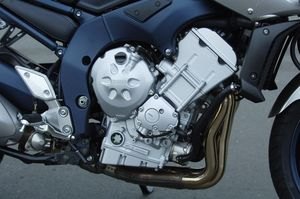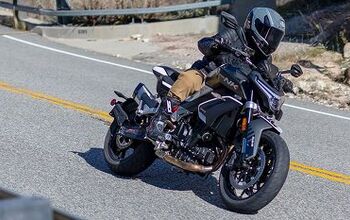2006 Yamaha FZ-1 - Motorcycle.com
Santa Rosa, CA -- Guerneville Road is scenic, yet mostly boring and straight. It runs along the Russian River and makes a few twists and turns as it meanders through the vineyards and pastures of Western Sonoma County. It's the road where, several years ago, I swapped bikes with my friend Racin' Jason and rode an FZ-1 for the first time.
I remember a big, rangy bike with long legs, plenty of power and a soft, squishy feel that was still fun. The big blue machine had a nice sound and a nicer look and feel. It was so much more comfortable than the CBR 600 F2 I had been riding for the previous 200 miles that I felt like sobbing with relief, yet I didn't seem to have trouble keeping up with Jason riding my race-replica.
Skip forward a few years to last April, when we at MO pitted an `05 YZF-R1 against an `05 FZ-1. The FZ-1 was actually the bike we at MO would have purchased using our own money. We all appreciated the comfort, power, versatility and friendly nature of the slightly cruder, but cheaper sibling of the fearsome race-replica R1.
The nits we picked were the same things many other R1 fans world wide noticed, like the wobbly tube frame, budget suspension and too much weight. What do we want? We want an R1 that's comfy but gives up nothing in terms of performance or handling.
Mr. Spock, set your taste buds to "drool." In September 2005, Yamaha released photos of an all-new FZ-1, also known as the "Fazer" in Europe. Details included a controlled-fill (CF) aluminum frame, inverted forks, a cool stump of an exhaust, flat bars on tall risers and that lovely current-generation R-1 motor. It looked great, but would we receive the full potential offered by this package, or would the production bikes be a heavier dumbed down version of the sneak-peek prototype?
To find out the answer to this and other pressing questions, MO dispatched me to the site of the FZ-1's USA press launch in lovely Santa Rosa, Calif., just 50 miles from my house in San Francisco. The ride would begin in the scenic wine country and take advantage of some of the most amazing riding roads in the country. I rode my personal bike there, prepared for a possible rain storm with my Aerostich suit and Widder electric vest.
Nobody rides without enduring a tech briefing, so we filed into the conference room for the ubiquitous PowerPoint presentation. It proved to be surprisingly brief and informative. I always like to hear about how the factories plan for a bike like the FZ-1 in a market that is lukewarm, at best, for sport-standards. Judging by the clamor on "Letters to the Editor" pages in motorcycle magazine, you'd think we Americans would buy sporty standards by the Hanjin container ship-load, but total sales of standards in the USA in 2005 (everything that isn't a dual-sport, sportbike, tourer or cruiser) totaled less than 20,000 units out of 600,000 streetbikes sold. I'll bet more people buy surplus mail jeeps.
However, it seems like a large portion of these bikes are FZ-1s. The old girl has a tremendous following, and it's easy to see why; it offers the most performance of any bike in the class (unless you count the K1200R) at a bargain price, plus it offers a great platform for customizing. Still, Yamaha's product planners and engineers wanted to make it better. Yamaha's guys stepped up to the podium to talk about how the bike was improved.
First, though, they told us that this bike was in a category separate from sportbikes and standards. The FZ-1 is a sport-standard, (Yamaha just calls the category "Sport") the best-selling one around; Yamaha's sales growth in this niche has outstripped the rest of the industry by 250 percent since 1999. Figuring out why doesn't take a genius; the FZ-1 makes the most power in a class full of liter-sized (and bigger) machines like the Honda 919, Kawasaki Z1000 and Aprilia Tuono.
Consumers want more than just a powerful motor. They also want handling, comfort and "rational" performance, wrapped up in "sexy styling" that will make them proud to own and ride the bike. Yamaha wants the FZ-1 to be a perfect balance between "radical" high performance and aggressive-handling bikes like the R1 and more rational-performing, comfortable bikes like the FJR 1300. The 2006 FZ-1 refines the older model's balanced qualities.
To figure out what aspects of the new FZ-1 to refine, Yamaha worked with current FZ-1 owners in focus groups and with surveys. These owners, mostly experienced enthusiasts in their mid to late forties, wanted Yamaha to improve the chassis and handling, so that's what the product planners focused on. This led to what is basically a brand-new bike.
Europe and other markets get the smart-looking fully naked version, but we `Mericuns will have to shut up and buy the bike with the fairing. Moto-journalists -- and mouthy letter-writing consumers-claim they want big naked standards, but Yamaha USA's product planners are too smart to fall for that. Each time a big naked is brought in without a fairing it gets outsold two or three to one by its fairing-equipped sister bike and is dropped after a few seasons, but the company is stuck stocking parts and other product support for the next ten years. If you want an FZ-1 with that cool, brutal, naked look, you'll have to buy a USA-spec bike and call a friendly dealer in the UK who will ship the necessary parts to the Colonies.
Fuel is now delivered by the R1's high-efficiency fuel injection, with 45 mm Mikuni throttle bodies. There's a motor-driven sub throttle valve in there to improve throttle response, as well as Yamaha's EXUP valve in the stylish "shorty" exhaust system to improve low and midrange power. All the gearing and motor changes result in a powerplant that has more torque in the low range than an '06 R1, but with seven more hp -- a claimed 148 -- than the '05 FZ-1. Sounds good on paper.
Where Yamaha's engineers and planners really focused was on the chassis and suspension. We at MO as well as FZ-1 owners complained about the heavy, soft, and squishy feel of the older FZ-1. Yamaha's response was to design a whole new chassis to "combine outstanding agile handling with great stability", according to the press materials. The result is a cast-aluminum design that utilizes controlled-fill castings for an extremely light and rigid design. It's almost 20 pounds lighter than the 2005's steel tube frame, while being 470 percent more rigid torsionally and 410 percent more rigid horizontally. The swingarm is also new, replacing the 2005's simple aluminum twin-beam with a cast unit that is much more rigid and 45 mm longer for improved power transfer and stability. Overall, the new frame balances chassis weight more forward, with 51 percent of the weight over the front wheel. That and the 57.5 inch wheelbase are intended to keep handling stable and confidence inspiring.
The seating position was also revised. The rider's "hip point" (a term originally coined by Sammy Davis, jr.) was moved forwards 49 mm, the rubber-mounted bar was dropped 25 mm lower and 10 mm closer to the rider, and the rubber-mounted footpegs are now 27 mm further back and 16 mm higher than the 2005's. The resulting position is intended to give "more control for aggressive riding" without sacrificing too much comfort.
All these changes to the motor, chassis and suspension result in a bike that is 24 pounds lighter (wet), with a 10 percent better power-to-weight ratio and improved throttle response, braking performance and more nimble handling. It will also produce fewer emissions with high-efficiency fuel injection and dual catalyzers in the exhaust. Remarkably, the price is only bumped up $500, to $9,099. "We consider it to be the ultimate package in a street motorcycle", said Yamaha product planning manager Derek Brooks.
More by Gabe Ets-Hokin



































Comments
Join the conversation